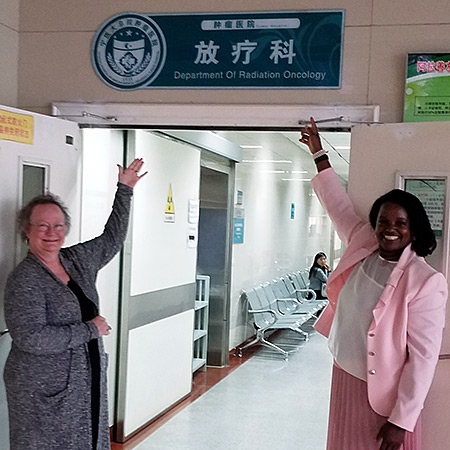Feb. 9, 2017
 Donors made it possible to find a new way to improve patient care at the General Hospital of Ningxia Medical University in Yinchuan, China.
Donors made it possible to find a new way to improve patient care at the General Hospital of Ningxia Medical University in Yinchuan, China.
This past fall, Pam Cartright, M.Ed., R.T.(R)(T), and Veleda Stephens, M.B.A., R.T.(T), worked as ASRT Foundation Community Outreach Fellows at the hospital to help finds ways for the staff to better serve the large number of patients they see every day.
The hospital is a comprehensive tertiary facility integrating clinical treatment, education, scientific research, examination and training in Ningxia. The staff provides medical services for Yinchuan, which is the capital of the Ningxia Hui Autonomous Region and home to nearly two million people, as well as the people in the nearby areas of Inner Mongolia, Shanxi province and Gansu province.
“The sheer number of patients the radiation therapists see make patient interactions brief,” Pam said. “Because there are only two linear accelerators, the therapists have to work quickly in order to treat every patient scheduled that day.”
Working alongside their colleagues, Pam and Veleda found ways to streamline the processes the hospital has in place that would allow therapists to provide more patient-centered care.
“The biggest thing we accomplished was to help them realize that they could enhance their workflows and become more efficient treating patients by going paperless,” Veleda said. “They have a lot of multiple-step processes that can be generated into software.”
While the hospital has excellent documentation, everything is manually documented in logs and manuals, which is time consuming, said Pam. Implementing a paperless process will help lessen the burden of trying to see so many patients. It also will enable the therapists to have better patient communications and to elevate patient privacy and confidentiality.
Pam and Veleda’s outreach fellowship continued the relationship the Foundation and its partner, RAD-AID International, have with the hospital. The Foundation and RAD-AID are committed to elevating the profession around the world through ongoing outreach efforts at hospitals like the one in Yinchuan. It is the generous support of donors that make it possible for R.T.s like Pam and Veleda to make a difference in underserved regions of the globe.
“I want to thank donors for supporting opportunities like the one Pam and I had,” said Veleda. “It was a true eye-opener and a great learning opportunity to see what more can be done to assist the staff at General Hospital of Ningxia Medical University.”
“Here in the United States, we are blessed with a lot of creative minds that are constantly developing innovative health care technology that moves our profession forward,” Pam said. “The support of the Foundation and its donors enables R.T.s to share the knowledge we are blessed with in other parts of the world. This knowledge-sharing, on both sides, is the true wealth made possible by donors. I am a Foundation donor for that very reason; I want to further the knowledge and understanding of medical imaging and radiation therapy globally.”
“Pam and I both believe that donors should continue their support for opportunities like the one we had,” Veleda said. The Foundation and RAD-AID are working to create sustainable change through ongoing partnerships with each hospital they work with, and that is only possible with support from donors.
Donor support is changing lives every day, and together we can ensure a brighter future for R.T.s, students and their patients.